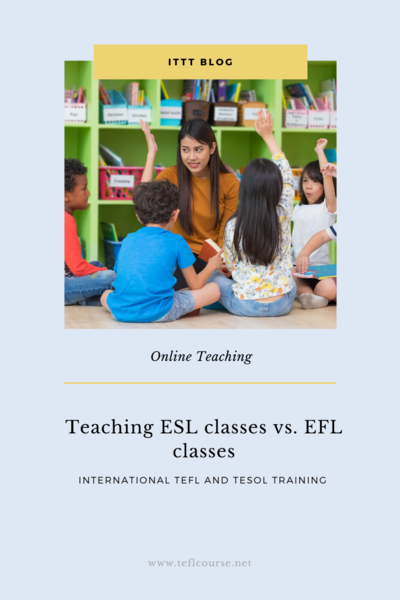Teaching ESL Classes vs. EFL Classes

Programs in English as a second language (ESL) generally take place in countries where English is the dominant or official language. People participating in an ESL program likely immigrated to an English-speaking country from a non-English speaking county and so are learning English as a language to be used in their everyday lives. In contrast, programs in English as a foreign language (EFL) generally take place in countries where English is not the official or dominant language. People participating in an EFL program are likely still in their home country and may or may not ever use English outside of the EFL classroom. This fundamental difference between the two types of programs can lead to differences in how English is taught in the classroom, even though the goal of both program types–-teaching students English–-is the same.
Table of Contents
Do you want to teach English abroad? Take a TEFL course!
This post was written by our TEFL certification graduate Rose P. Please note that this blog post might not necessarily represent the beliefs or opinions of ITTT.
What is ESL?
With an ESL program, instructors can assume students have a practical need to learn English. Adult students probably already have a [job](How do I get a job teaching English in Thailand?) that requires they learn English or are actively looking for one that will require it. Younger students are probably taking the ESL class as a precursor to or as an addition to a normal school (all of which is in English). Because of this, the students will likely be very motivated to learn and will have specific daily-life needs that the class curriculum should meet, such as how to ask for directions or talk to a cashier. Lessons should focus more on situational English lessons and less on formal English grammar lessons, and the specific situations covered should be catered to each group of students based on their English level, age, and specifics of their present needs.

Also Read: How long does it take to get a TEFL job?
Though united by their practical need for English, ESL students in any given class may come from many different non-English-speaking countries. Because of this they likely will not be able to communicate with each other in their native languages, which forces them to practice English even more if they want to talk to their classmates. However, it also means a student struggling to explain something or answer a question cannot speak to a classmate in their native language to clarify or guide their answer. Teachers of ESL should, therefore, be aware of every student's English level, as well as the native languages of each student, and plan on how to best help struggling students during lessons, through lesson structure and pairings during group activities.
Because of the melting pot of languages and cultures that ESL classes can be, the teacher should also be very open-minded and culturally aware when interacting with students and having students interact with each other. One of the best ways to do this is for the teacher to learn a bit about each student's culture and have students share their cultures. In addition to educating their classmates, sharing their culture with others may help students feel they are not losing their home culture to immerse themselves in the culture of their new, English-speaking home. Specific lessons on the English-speaking customs would also be important.

Also Read: Top 10 Places to Take Your TEFL Course in Winter
What is EFL?
With an EFL program, students do not necessarily have a practical need for English and will never actually use it in their everyday lives. Younger students are probably learning English as a class in school, the rest of which is in their native language. Adult students are probably learning English for fun or a short-term trip to an English-speaking country. As such, EFL lessons are more likely to focus on formal grammar lessons and less on specific vocabulary for different situations, though situational lessons will still occur. Students may or may not be motivated to learn English as a result. Teachers of EFL should be aware of this and try to relate English to their students' everyday lives or point to the usefulness of learning English as much as possible.
It is also important for an EFL teacher to ensure students are interacting in English during the class. EFL students in a class are probably all or mostly from the same country and so likely have the same native language. This makes it tempting for students to talk to each other in their native language during group activities and other parts of class rather than in English. The teacher should try to incentivize using English (or disincentivize using students' native language), though there should be some room in this system for a struggling student to ask their peers for help in their native language to clarify concepts or help with answering questions and completing tasks.
The students' shared native language probably also reflects a shared culture. As such, in addition to learning English, teachers should also include lessons on the cultures of various English-speaking countries in order to make English seem more real or useful (since learning about the various places English is spoken drives home the idea that English would be good to learn in order to travel) and to expose the students to cultures besides their own. It is also important for the teacher to understand their students' culture so that they can connect English to it, as well as interact with students, parents, and other teachers in a culturally sensitive manner.
Do you want to teach English abroad? Take a TEFL course!
Both ESL and EFL classes aim to teach students how to use English well. The fundamental difference between ESL and EFL classes is based on the dominant language of the country in which the English classes are taking place. ESL classes take place in countries where English is a dominant or official language, while EFL classes take place in countries where English is not a dominant or official language. This dissimilarity leads to differences in student motivations for learning English, the parts of English the students learn, and other aspects of the English class.
Apply now & get certified to teach english abroad!
Speak with an ITTT advisor today to put together your personal plan for teaching English abroad.
Send us an email or call us toll-free at 1-800-490-0531 to speak with an ITTT advisor today.
Related Articles:
- 10 Tips for Teaching Grammar to EFL Students Abroad
- Top 10 Things To Know When Moving Abroad To Teach English
- 4 Top Tips For Getting Your TEFL Certificate on the Road
- What TEFL course is most useful?
- What's Stopping You from Teaching English Abroad?
- The Best Countries to Teach ESL When You're 50+




